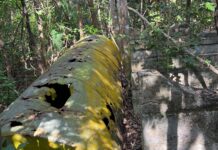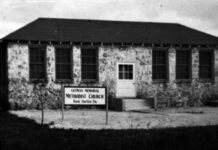Art “Silver Bar” McKee is a celebrated Florida Keys treasure hunter. He was born in Bridgeton, New Jersey, on Nov. 2, 1910, and always loved the water.
As a young man, he worked as a lifeguard at a New Jersey public pool. When an August storm poured for four hours and dropped 11 inches of rain on and around Bridgeton, two area lakes were overwhelmed, the earthen dams created to contain them cracked and a wall of water pushed down the Cohansey River. The 1934 flood destroyed the bridges connecting the east side of Bridgeton to the west side. The event changed McKee’s life.
A hard hat diver was hired to help clear the river of debris. McKee was hired as his assistant and worked as the diver’s line tender to make sure there was a constant flow of oxygen. Art was hooked. He wanted to be a hard hat diver. McKee moved to Homestead, Florida, in 1937, where he worked as a lifeguard, saved up some money, and bought a used hard hat diving rig. In 1938, a local fisherman named Reggie Roberts asked McKee if he wanted to see a shipwreck that he had spotted off Key Largo, between Rodriguez and Tavernier keys.
The ship was the capitana, the lead military escort of the ill-fated 1733 Treasure Fleet that was wrecked along the reef line of the Upper Keys by a September hurricane. That wreck was later identified as the Spanish galleon El Rubi. The discovery of El Rubi and subsequent ships from the 1733 fleet has been marked as the modern rediscovery of the lost ships from this tragic fleet.
The exploration of that wreck facilitated the progression of Art McKee, lifeguard and hard hat diver, to Art McKee, the father of modern-day treasure hunting.
Art McKee was not the first hard hat diver to explore the warm, clear shallows surrounding the Florida Keys, nor the first to salvage sunken ships. He shared that history with the Danish-born Carl Herluf Holm, who, at 12 years of age, ran away from his Copenhagen school and attempted to join an expedition venturing out towards the North Pole. It did not take long for those in charge to discover that Carl was four years shy of the minimum crew age of 16. Though the boy was returned to his home, he continued to run away. So, at 14, his father entered him as an unpaid apprentice aboard a Danish navy ship. By 16, he had become the Danish navy’s youngest hard hat underwater diver.

Like McKee, Holm found his way to South Florida and settled in the Miami area. He also formed the U.S. Marine Salvage Company. In a 1929 article from The Miami News, Holm confessed, “I love the sea bottom… I can’t keep away from it. Sometimes I just stop my work ‘down there’ and sit down on a rock to look about. It is fairy land.”
According to a 1934 article published in The Miami News, Holm and his crew were investigating a shipwreck discovered near the Florida Reef in the shallow waters surrounding the Florida Keys. Though it was not revealed near which of the islands Holm and his salvage company were exploring, the reason why they chose those particular shallows was a familiar one. Some local fishermen had cast their nets near a white, sandy bottom, and the net’s little woven squares had become entangled on unsuspected debris.
Upon closer examination of the area, two cannons and ship timbers were reported sticking up from the bottom’s sandy surface. Holm brought his hard hat diving gear and the U.S. Marine Salvage Company to investigate the wreck site. While iron cannons and other unidentified artifacts were recovered, there was no silver, and the ship’s identity was never revealed. It could have been one of the ships destroyed by that September hurricane in 1733 or any one of the hundreds if not thousands of other ships wrecked along the Florida Reef.
While McKee went on to become synonymous with salvaging ships from the Spanish fleet and earning the honorary title of Father of Modern Treasure Hunting, Holm possibly etched out his own place in the history books. According to the author and local historian Charles Brookfield, in 1934, Carl Holm reportedly dislodged the iron ring famously driven into Black Caesars Rock and used by at least two pirates named Black Caesar. He also sent it to the Smithsonian Institute.
On several occasions, I have reached out to the Smithsonian, as well as to individual curators working for the museum, in hopes of finding corroboration about the donation. Without providing additional information, the institution has no way of tracking down the artifact. Also, after 1934, newspaper articles were written about the infamous pirate of Elliott Key named Black Caesar that sometimes mentioned the iron ring or, in some cases, iron rings. These writers claim to have seen the ring still attached to the rock, though it has now long since disappeared. It looks like the whereabouts of the iron ring will remain just another twist in the legendary tale of the pirate Black Caesar and Carl Holm a footnote in the history of the Florida Keys.





















